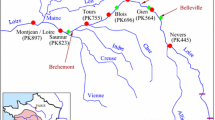Abstract
A tank model consisting of three tanks was developed for prediction of runoff and sediment yield. The sediment yield of each tank was computed by multiplying the total sediment yield by the sediment yield coefficients; the yield was obtained by the product of the runoff of each tank and the sediment concentration in the tank. The sediment concentration of the first tank was computed from its storage and the sediment concentration distribution (SCD); the sediment concentration of the next lower tank was obtained by its storage and the sediment infiltration of the upper tank; and so on. The SCD, caused by the incremental source runoff (or the effective rainfall), was obtained by the theory of the instantaneous unit sediment graph (IUSG) and a sediment routing function. Using the SCD, the sediment yield was computed from the tank model as well as by the IUSG model. The sediment yield obtained from the tank model was then compared with that from the IUSG model. Finally, the tank model was verified on an upland watershed in northwestern Mississippi.
Similar content being viewed by others
References
Bowie, A. J. and Bolton, G. C., 1972 ‘Variations in runoff and sediment yields of two a djacent watersheds as influenced by hydrologic and physical characteristics’, Proceedings, Mississippi Water Resources Conference, Water Resources Research Institute, Mississippi State University, Mississippi State, Mississippi, pp. 37–55.
Chen, V. J. and Kuo, C. Y., 1984 ‘A study of synthetic sediment graphs for ungaged watersheds,’ J. Hydrol. 84, 35–54.
Lee, Y. H. and Singh, V. P., 1999 ‘Prediction of sediment yield by coupling kalman filter with instantaneous unit sediment graph’, Hydrolog. Process. 2861–2875.
Nash, J. E. 1957 ‘The form of the instantaneous unit hydrograph’, Publ. 42. International Association of Scientific Hydrology, Wallingford, England, pp. 114–121.
Nash, J. E. 1958 ‘Determining runoff from rainfall,’ Proceeding of the Institution of Civil Engineers, Ireland, vol. 10, pp. 163–184.
Nash, J. E. 1959 ‘Systematic determination of unit hydrograph parameters,’ J. Geophys. Res. 64(1), 111–115.
Nash, J. E. 1960 ‘A unit hydrograph study with particular reference to British catchments’, Proceeding of the Institution of Civil Engineers, London, vol. 17, pp. 249–282.
Rendon-Herrero, O., 1974 ‘Estimation of wash load produced on certain small watersheds,’ J. Hydraul. Div., Proc. ASCE 100(HY), 835–848.
Rendon-Herrero, O., 1978 ‘Unit sediment graph,’ Water Resour. Res. 14(5), 889–901.
Singh, V. P. (ed.), 1982 Applied Modeling in Catchment Hydrology, Water Resources Publications, Littleton, Colorado.
Singh, V. P., Baniukiwicz, A., and Chen V. J., 1982 ‘An Instantaneous Unit Sediment Graph Study for Small Upland Watersheds,’ Water Resources Publications, Littieton, Colorado.
Singh, V. P., 1988 Hydrologic Systems: Vol. 1, ‘Rainfall-Runoff Modeling,’ Prentice Hall, Englewood Cliffs, New Jersey, pp. 215–222.
Singh, V. P., 1989 Hydrologic Systems: Vol. 2, ‘Watershed Modeling,’ Prentice Hall, Englewood Cliffs, New Jersey, pp. 221–226.
Singh, V. P., 1992 Elementary Hydrology, Prentice-Hall, pp. 731–735.
Srivastava, P. K., Rastogi, R. A. and Chanhan, H. S., 1984 ‘Prediction of storm sediment yield from a small watershed’, J. Agri. Engin. 21(1–2), 121–126.
Sugawara, M., 1979 ‘Automatic calibration of the tank model’, Hydrolo. Sci. Bull. 24, 375–388.
Sugawara, M., 1995 ‘Tank model’, in V. P. Singh, (ed.),Computer Models of Watershed Hydrology, Water Resources Publications, Littleton, Colorado.
Sugawara, M., Watanabe, I., Ozaki, E. and Katsuyama, Y., 1984 ‘Tank model with snow component’, Research Notes, No. 65, National research Center for Disaster Prevention, Japan.
Williams, J. R., 1975a ‘Sediment routing for agriculture watersheds,’ Water Resour. Bull. 11(5), 965–974.
Williams, J. R., 1975b ‘Sediment yield prediction with universal equation using runoff energy factor’, in Present and Prospective Technology for Predicting Sediment Yields and Sources, ARS-S-40, Agricultural Research Service, U.S. Department of Agriculture, Washington D.C., pp. 244–252.
Williams, J. R., 1978a ‘A Sediment yield routing model,’ Proceedings of the Specialty Conference on Verification of Mathematical and Physical Models in Hydraulic Engineering, ASCE, August 9–11, pp. 662–670.
Williams, J. R., 1978b ‘A sediment graph model based on an instantaneous unit sediment graph’, Water Resour. Res. 14(4), 659–664.
Author information
Authors and Affiliations
Corresponding author
Rights and permissions
About this article
Cite this article
Lee, Y.H., Singh, V.P. Tank Model for Sediment Yield. Water Resour Manage 19, 349–362 (2005). https://doi.org/10.1007/s11269-005-7998-y
Received:
Accepted:
Issue Date:
DOI: https://doi.org/10.1007/s11269-005-7998-y




